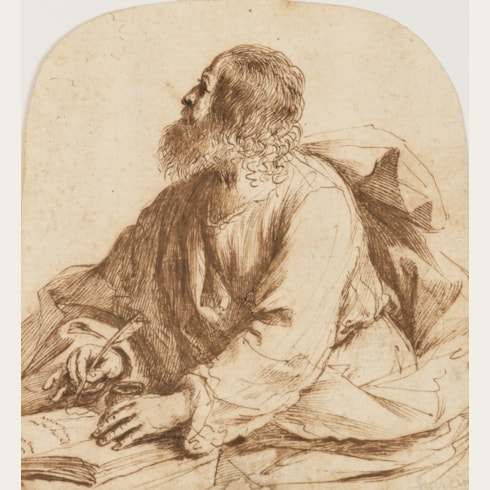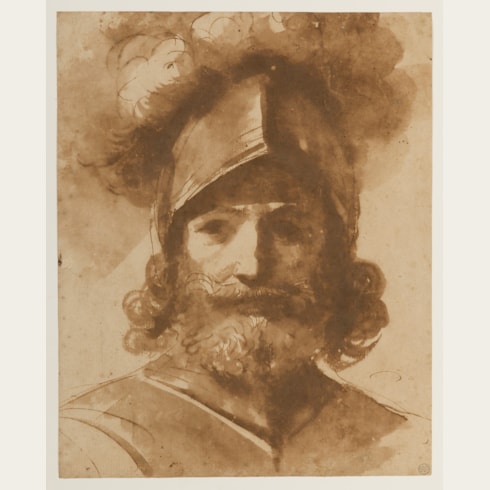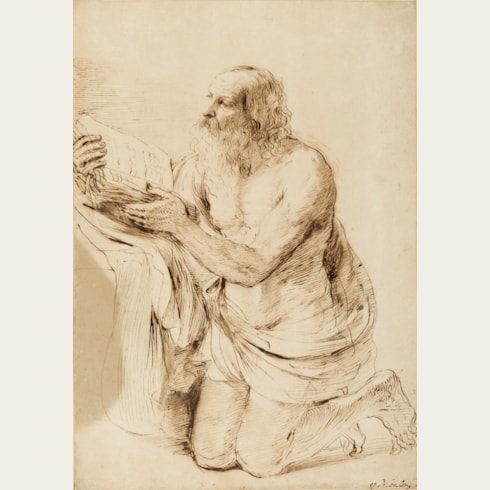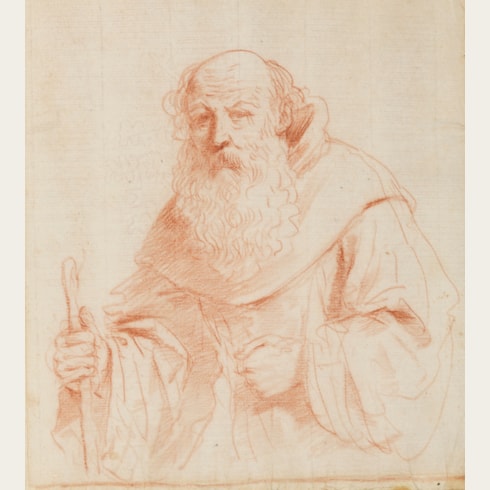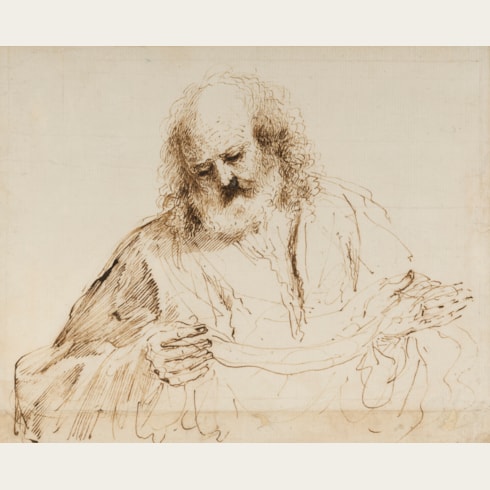Giovanni Francesco Barbieri GUERCINO
(Cento 1591 - Bologna 1666)
A Man Reading a Book, in Profile to the Left
195 x 136 mm. (7 5/8 x 5 3/8 in.)
In superb condition, this drawing epitomizes Guercino’s use of a stipple and line technique that was first developed in drawings intended to be engraved by his associate, the printmaker Giovanni Battista Pasqualini. However, Guercino continued to work in this so-called ‘gravure’ style in genre drawings of the late 1630s and 1640s, such as the present sheet, that are unconnected with prints. Characteristic of these drawings is the stippling on the face of the figure and the treatment of his hair. As one scholar has noted, ‘the texture of hair seems to have fascinated Guercino, and few draftsmen represented it as adeptly. Whether head-born or face-worn, hair is used subtly to bring a sense of verisimilitude and realism to Guercino’s figures and compositions…Through virtuoso penwork and a multiplicity of lines, many of Guercino’s designs for prints exemplify the artist’s particular awareness of texture…Unfortunately, such details were often lost on the engraver.’
Although not necessarily made to be reproduced in print form, Guercino’s ‘gravure’ drawings, typified by this Man Reading a Book, in Profile to the Left, were sometimes used as models by printmakers long after the artist’s death. The present sheet may be likened, in stylistic terms, to pen and ink drawings such as a study of A Woman in Profile to the Left in the Blanton Museum of Art at the University of Texas in Austin, a Seated Woman in the Ashmolean Museum in Oxford, which was later etched by Giuseppe Zocchi in the 18th century, and a Saint John the Evangelist in Meditation in the Achenbach Foundation for Graphic Arts at the Fine Arts Museums of San Francisco, which was also reproduced as an engraving by the Bolognese printmaker Domenico Bonaveri sometime in the early 18th century. As David Stone has written of the Achenbach drawing, in terms equally appropriate to the present sheet, ‘Drawings of the later 1640s like Guercino’s St. John…have an arresting calmness and stability that seem almost neo-classical in feeling.’
Other comparable pen drawings include a study of a young man in the Galleria dell’Accademia in Venice and two profile drawings of An Unshaven Pope and a Young Man Wearing a Large Soft Hat, both in the collection of the Princeton University Art Museum, New Jersey.
Giovanni Francesco Barbieri, known as Il Guercino (‘the squinter’) because he was cross-eyed, was by the second decade of the 17th century one of the leading painters in the province of Emilia. Born in Cento, a small town between Bologna and Ferrara, Guercino was largely self-taught, although his early work was strongly influenced by the paintings of Ludovico Carracci. In 1617 he was summoned to Bologna by Alessandro Ludovisi, the Cardinal Archbishop of Bologna, and there painted a number of important altarpieces, typified by the Saint William Receiving the Monastic Habit, painted in 1620 and now in the Pinacoteca Nazionale in Bologna. When Ludovisi was elected Pope Gregory XV in 1621, Guercino was summoned to Rome to work for the pontiff and his nephew, Cardinal Ludovico Ludovisi. It was in Rome that Guercino painted some of his most celebrated works, notably the ceiling fresco of Aurora in the Casino Ludovisi and the large altarpiece of The Burial and Reception into Heaven of Saint Petronilla for an altar in Saint Peter’s. The papacy of Gregory XV was short-lived, however, and on the death of the Pope in 1623 Guercino returned to his native Cento. He remained working in Cento for twenty years, though he continued to receive commissions from patrons throughout Italy and beyond, and turned down offers of employment at the royal courts in London and Paris. Following the death of Guido Reni in 1642, Guercino moved his studio to Bologna, where he received commissions for religious pictures of the sort that Reni had specialized in, and soon inherited his position as the leading painter in the city.
Guercino was among the most prolific draughtsmen of the 17th century in Italy, and his preferred medium was pen and brown ink, although he also worked in red chalk, black chalk, and charcoal. He appears to have assiduously kept his drawings throughout his long career, and to have only parted with a few of them. Indeed, more drawings by him survive today than by any other Italian artist of the period. On his death in 1666 all of the numerous surviving sheets in his studio passed to his nephews and heirs, the painters Benedetto and Cesare Gennari, known as the ‘Casa Gennari’.
The drawings of Guercino, which include figural and compositional studies, landscapes, caricatures and genre scenes, have always been coveted by later collectors and connoisseurs. Indeed, the 18th century amateur Pierre-Jean Mariette noted of the artist that ‘Ce peintre a outre cela une plume tout-à-faite séduisante’. The largest extant group of drawings by Guercino is today in the Royal Collection at Windsor Castle; these were acquired from the Gennari family by King George III’s librarian, Richard Dalton, between about 1758 and 1764.
Provenance
Carta Ltd., London, in 2021
Private collection, London.





















